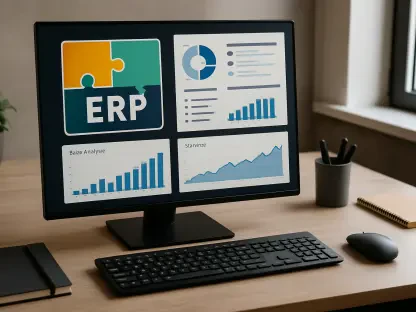In the fast-paced realm of digital innovation, web design continues to evolve at a remarkable speed, and WordPress stands as a cornerstone for millions of creators and businesses aiming to carve out a distinctive online presence. Powering over 43% of all websites globally, this platform’s unparalleled flexibility, scalability, and extensive ecosystem of plugins and themes make it a preferred choice for everyone from small startups to multinational corporations. As user expectations shift and technology advances, staying ahead of design trends becomes not just an advantage but a necessity for maintaining relevance in a crowded digital landscape. The latest insights drawn from leading examples such as TechCrunch, BBC America, and Disney reveal a clear direction for where WordPress design is headed. This exploration delves into the most impactful trends shaping websites on this platform, highlighting strategies that prioritize engagement, functionality, and aesthetic appeal. By examining these emerging patterns, businesses and designers can gain a deeper understanding of how to leverage WordPress’s capabilities to create experiences that resonate with modern audiences. From prioritizing user needs to embracing cutting-edge visual storytelling, the focus is on crafting sites that not only look impressive but also deliver measurable results in a competitive online environment.
Prioritizing the User Experience
A fundamental shift in web design philosophy has placed user-centric approaches at the forefront of creating successful digital platforms on WordPress. This trend emphasizes tailoring every aspect of a website to meet the needs and expectations of visitors, ensuring they can navigate effortlessly and find value without unnecessary hurdles. Sites like TechCrunch exemplify this by organizing vast amounts of content into intuitive layouts with clear hierarchies, making it simple for users to locate articles or updates during high-traffic periods. The emphasis on usability extends beyond just structure to include accessibility features, such as readable fonts and logical menu systems, which cater to a diverse audience. Designers are increasingly focusing on reducing friction points, ensuring that whether a user seeks information or aims to make a purchase, the journey remains smooth and satisfying. This approach reflects a broader understanding that a website’s primary role is to serve its audience, transforming casual visitors into loyal users through thoughtful, empathetic design choices.
Beyond the basics of navigation, user-centric design also involves anticipating how people interact with content in real-time scenarios. For instance, integrating features like personalized content recommendations or search functionalities can significantly enhance engagement by delivering tailored experiences. WordPress offers a range of tools and plugins that allow for such customization, enabling designers to analyze user behavior and adapt interfaces accordingly. This dynamic responsiveness ensures that websites remain relevant to shifting user preferences, addressing pain points like slow navigation or irrelevant information. Additionally, the focus on creating emotionally resonant experiences—through design elements that evoke trust or excitement—plays a crucial role in building lasting connections. As this trend solidifies, the expectation is that WordPress sites will continue to refine these strategies, leveraging data and feedback to craft digital spaces that feel both intuitive and indispensable to their users.
Embracing Mobile-First Strategies
With mobile devices accounting for a significant portion of internet traffic, adopting a mobile-first design strategy has become a non-negotiable standard for WordPress websites. This approach involves designing for smaller screens as the primary focus, ensuring that layouts, features, and content are optimized for mobile users before scaling up to desktop versions. Examples like BBC America and Bata demonstrate how seamless cross-device experiences can be achieved, delivering consistent functionality and visual appeal whether accessed on a smartphone or a larger screen. Responsive design ensures that images resize appropriately, menus collapse into user-friendly formats, and touch interactions are prioritized for ease of use. This trend reflects the reality that many users now rely on mobile devices as their primary gateway to the internet, making accessibility on-the-go a critical factor in retaining attention and driving engagement.
Moreover, mobile-first design goes beyond mere aesthetics to address performance challenges unique to portable devices, such as variable internet speeds and limited screen real estate. WordPress developers are increasingly leveraging lightweight themes and optimized assets to ensure fast loading times, even on slower connections, preventing users from abandoning sites due to delays. Features like Accelerated Mobile Pages (AMP) are becoming commonplace, further enhancing speed and usability for mobile audiences. This focus also extends to ensuring that key actions—such as making purchases or accessing critical information—are streamlined for smaller interfaces, reducing the steps needed to complete a task. As mobile usage continues to dominate, the integration of these practices into WordPress design workflows signals a commitment to inclusivity, ensuring that no user is left behind regardless of how they choose to connect.
Harnessing the Power of Minimalism
Minimalism in web design has re-emerged as a potent trend on WordPress platforms, driven by a desire to eliminate clutter and focus on what truly matters to visitors. This approach, exemplified by the TED Blog, prioritizes simplicity through clean layouts, ample white space, and sharp typography, directing attention to core content or calls to action without overwhelming the senses. By stripping away unnecessary elements, designers create environments where users can engage with material more deeply, whether it’s reading an article or browsing a product catalog. This intentional reduction of visual noise not only enhances readability but also conveys a sense of sophistication and clarity, aligning with modern preferences for straightforward, distraction-free digital interactions.
The effectiveness of minimalism lies in its strategic execution, where every remaining element serves a specific purpose in guiding user behavior or reinforcing brand identity. On WordPress, this can be achieved through carefully curated color palettes and restrained use of imagery, ensuring that the design feels cohesive rather than sparse. Performance benefits also play a significant role, as simpler designs often result in faster load times, a critical factor for retaining impatient users and improving search engine rankings. This trend encourages a disciplined approach to content curation, prompting businesses to distill their messaging to its essence before presenting it online. As minimalism gains traction, it challenges designers to balance aesthetic restraint with impactful communication, proving that a less-is-more philosophy can yield powerful results in capturing and holding user interest.
Integrating Multimedia for Engagement
The rise of multimedia and interactive elements marks a significant direction for WordPress web design, as brands seek to captivate audiences in increasingly dynamic ways. Platforms like BBC America illustrate how video, audio, and other rich content can be seamlessly woven into a site’s fabric, creating immersive experiences that hold user attention longer than static text or images alone. These elements, when optimized for quick loading and intuitive placement, transform a website into an engaging storytelling medium, ideal for showcasing products, sharing news, or building emotional connections. WordPress’s robust support for plugins enables this integration, allowing for everything from embedded media players to subtle animations that enhance rather than detract from the user journey.
However, the challenge lies in balancing these captivating features with the need for performance, as heavy multimedia can slow down a site if not handled with care. Advanced compression techniques and lazy loading are becoming standard practices among WordPress developers to ensure that interactive content doesn’t compromise speed or accessibility across devices. Additionally, the trend leans toward purposeful interactivity—think clickable infographics or short, impactful videos—designed to add value rather than serve as mere decoration. This focus ensures that multimedia elements align with user intent, providing information or entertainment in formats that resonate with modern consumption habits. As this direction evolves, expect WordPress sites to push boundaries in how they blend technology with creativity, offering experiences that feel both innovative and indispensable to their audiences.
Crafting Brand Narratives Visually
A website serves as a digital reflection of a brand’s identity, and aligning design with that identity through visual storytelling has become a dominant trend on WordPress. Taking inspiration from Disney’s corporate platform, this approach involves using every visual element—color schemes, typography, imagery—to convey a brand’s values, history, and personality in a cohesive manner. Such deliberate design choices create an immediate connection with visitors, reinforcing recognition and trust before a single word is read. This trend underscores the importance of consistency, ensuring that the online presence mirrors the essence of what the brand stands for, whether it’s innovation, heritage, or accessibility, thereby fostering a deeper emotional bond with the audience.
This focus on visual storytelling extends to how specific design elements are chosen to evoke particular responses or associations among users. For instance, a tech company might opt for sleek, futuristic aesthetics to suggest cutting-edge expertise, while a heritage brand could lean on classic fonts and warm tones to evoke nostalgia. WordPress’s vast library of customizable themes and design tools makes it easier than ever to tailor these elements to precise specifications, allowing even small businesses to compete with larger entities in terms of polished presentation. The trend also encourages a narrative-driven structure, where content and visuals work together to guide users through a brand’s story, from mission to offerings. As visual branding continues to shape user perceptions, WordPress designers are tasked with translating complex identities into intuitive, memorable online experiences that leave lasting impressions.
Optimizing for Both Beauty and Speed
Striking a balance between captivating aesthetics and robust performance remains a critical focus for WordPress web design, as users demand sites that are both visually stunning and lightning-fast. Examples like TechCrunch and the TED Blog demonstrate that it’s possible to deliver eye-catching designs without sacrificing load times or functionality, a balance that’s essential for keeping visitors engaged and improving search engine visibility. Performance optimization involves leveraging WordPress’s ecosystem of plugins for image compression, caching, and code minification, ensuring that even the most intricate designs don’t bog down a site’s responsiveness. This trend highlights a growing recognition that beauty alone isn’t enough—functionality must match form to meet modern expectations.
Delving deeper, this balance requires a meticulous approach to resource management, where every design asset is scrutinized for its impact on speed and user experience. Developers are increasingly adopting practices like deferred loading of non-critical elements and prioritizing above-the-fold content to create the perception of instant access. Additionally, the use of content delivery networks (CDNs) to distribute site resources globally is becoming more prevalent among WordPress users aiming to cater to international audiences with minimal latency. This dual focus on aesthetics and efficiency ensures that websites not only draw users in with compelling visuals but also retain them through seamless interactions. As performance metrics continue to influence user satisfaction and rankings, the commitment to optimization within WordPress design workflows signals a mature approach to meeting the demands of a digital-first world.
Reflecting on Design Evolution
Looking back, the journey of WordPress web design showcases a remarkable adaptation to shifting user needs and technological advancements, as evidenced by the diverse strategies employed by leading platforms. The emphasis on user-centric layouts, mobile optimization, and purposeful minimalism reflects a deep understanding of what makes digital experiences successful in a competitive landscape. Multimedia integration and visual storytelling stand out as powerful tools that enrich engagement, while the relentless focus on performance ensures that aesthetics never come at the expense of functionality. Each of these trends, drawn from real-world applications, highlights WordPress’s versatility in supporting varied goals across industries. For businesses and designers moving forward, the takeaway is clear: prioritize intentional design that aligns with user expectations and brand identity. Exploring the extensive array of WordPress tools and staying attuned to emerging user behaviors will be key steps in crafting websites that not only stand out but also deliver sustained value in an ever-evolving digital arena.









